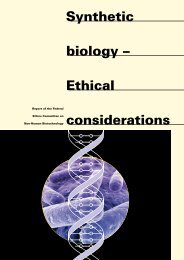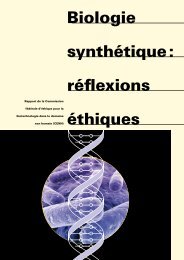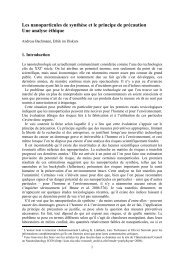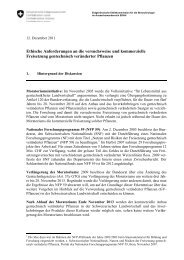Helmut Segner Fish Nociception and pain A biological perspective
Helmut Segner Fish Nociception and pain A ... - EKAH - admin.ch
Helmut Segner Fish Nociception and pain A ... - EKAH - admin.ch
- No tags were found...
Create successful ePaper yourself
Turn your PDF publications into a flip-book with our unique Google optimized e-Paper software.
nociceptors as well as slow <strong>and</strong> fast adapting mechanical receptors<br />
(Sneddon et al. 2003a, Ashley et al. 2007). All receptor types except<br />
mechanothermal receptors showed an increase in peak firing<br />
frequency with increased strength of stimulation, with evidence of<br />
response saturation at higher intensities (Ashley et al. 2007). The<br />
mechanical thresholds were higher in the polymodal than in the<br />
mechanical receptors, but generally they were very low compared<br />
to the thresholds of mechanoreceptors in the skin of mammals.<br />
Sneddon (2003a) speculated that this is a compensatory feature to<br />
the more easily damageable nature of fish skin. Thermal nociceptors<br />
of trout showed a threshold that was about 10 °C lower than the<br />
thermal threshold of mammalian thermal nociceptors, <strong>and</strong> none<br />
of the tested receptors gave any response to water temperatures<br />
below 7 °C, indicating an absence of cold receptors (Ashley et al.<br />
2007). Both properties might be explained by the poikilothermic<br />
physio logy of fish. Overall, the results from this series of studies<br />
provide good evidence for the presence of nociception in teleostean<br />
fish, <strong>and</strong> that the properties of the nociceptors are adapted to<br />
the specific <strong>biological</strong> properties of fish. This conclusion agrees<br />
with the conclusion from the EFSA Report (2009) which says<br />
that “there is good scientific evidence that fish possess the sensory<br />
equipment for detecting potentially <strong>pain</strong>ful stimuli”.<br />
In mammals, the next step after peripheral nociception is<br />
the processing of the nociceptive signals at the spinal cord level<br />
(see above). <strong>Fish</strong>, in general, show an organization of major<br />
spinal pathways that is similar to mammals, including spino-thalamic,<br />
spino-mesencephalic, spino-reticular <strong>and</strong> spino-limbic<br />
tracts (Ch<strong>and</strong>roo et al. 2004a). This similarity suggests that spinal<br />
tracts of fish function in carrying nociceptive signals to the<br />
brain, although to date actual experimental confirmation of this<br />
assumption is not available. What, however, has been shown is the<br />
presence of neuronal activities in the brain of fish after cutaneous<br />
noxious stimulation (Dunlop <strong>and</strong> Lamig 2005), indicating that<br />
peripheral nociceptive signals reach the brain. This observation<br />
provides indirect evidence for the functioning of the spinal cord<br />
of fish in nociceptive transmission.<br />
3.2 Pain perception: neuroanatomical evidence<br />
3.2.1 The fish brain<br />
The brain anatomy of teleostean fish is rather diverse, reflecting<br />
their diverse habitats <strong>and</strong> modes of life (Butler <strong>and</strong> Hodos 1996,<br />
Kotrschal et al. 1998, Nieuwenhuys et al. 1998, Wulliman 1998).<br />
As emphasized by Rose (2002):<br />
“<strong>Fish</strong> brains are not merely simpler versions of mammalian or amphibian<br />
or reptilian brains, but they can have highly diverse, unique<br />
adaptations due to their diverse evolutionary paths.”<br />
For instance, electro-sensing mormyrid fish have a specific structure,<br />
the valucla, for the central processing of electric stimuli.<br />
Independent of species variations, however, the fish brain comprises<br />
the principal elements of the vertebrate brain, as also found<br />
in human brain (see above): telencephalon (with the olfactory<br />
lobe), diencephalon, mesencephalon (with the optic tectum), metencephalon<br />
(with the cerebellum), <strong>and</strong> myelencephalon (Figure 5).<br />
The teleost telencephalon receives input from the olfactory bulbs,<br />
but there are large areas of the pallium which are not devoted to<br />
olfactory input <strong>and</strong> are involved in other functions (see below).<br />
The telencephalon shows many reciprocal connections with the<br />
other parts of the brain. Advanced teleost fish like the percids tend<br />
to enlarge the midbrain <strong>and</strong> develop a prominent optic tectum in<br />
order to process the sensory information from the visual system<br />
as well as from the lateral line system, which provides the fish<br />
Figure 5: External morphology <strong>and</strong> the<br />
anatomical location of the fish brain.<br />
(Modified from www.britannica.com/<br />
EBchecked/topic/452101/perch.)<br />
Cerebellum<br />
Cerebrum<br />
Optic Lobe<br />
Hypothalamus <strong>and</strong> Pituitary<br />
Olfactory bulb<br />
34 <strong>Fish</strong>. <strong>Nociception</strong> <strong>and</strong> <strong>pain</strong> | Contributions to Ethics <strong>and</strong> Biotechnology<br />
<strong>Fish</strong>. <strong>Nociception</strong> <strong>and</strong> <strong>pain</strong> | Contributions to Ethics <strong>and</strong> Biotechnology<br />
35









